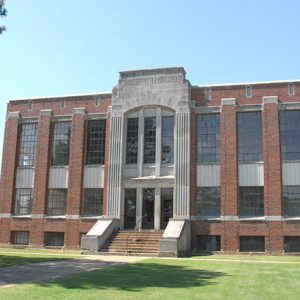calsfoundation@cals.org
Waldron Commercial Historic District
The Waldron Commercial Historic District comprises a collection of buildings along Main Street from 1st to 5th Street in downtown Waldron (Scott County). Within the boundaries of the historic district are thirty-four buildings and one additional structure, built in several different phases between the years 1880 and 1958. Of the thirty-five total structures, twenty maintain a high level of integrity and contribute to the historic district; the other fifteen are non-contributing. The district was placed on the National Register of Historic Places on September 25, 2008.
The oldest buildings remaining in the Waldron Commercial Historic District date from circa 1880; however, development on Main Street began prior to that time. In the late 1830s, resident William Featherston operated a tavern where the Ben Franklin Building now stands between 3rd and Danville streets. Between the years 1850 and 1859, Waldron had three grocery stores, two hotels, a courthouse, a jail, a post office, and a blacksmith. The 1840s log courthouse was replaced in 1860 with a brick structure, but it burned two years later during the Civil War. The Continental Hotel, also referred to as the Malone Hotel, was erected in 1869 on the east side of South Main Street. The so-called Waldron War, a period of violence in the 1870s between Confederate and Union supporters, caused the town to suffer economically until the end of the decade.
Many new brick commercial buildings were built on Main Street during the 1880s and 1890s, including the Boston Cash Store Building in 1880 and the Dozier and Son Building in 1890. Businesses flourished on Main Street after the turn of the century. In 1901, the Bank of Waldron and the First National Bank both opened on South Main Street. By 1902, the Kansas City Southern Railroad went through Waldron, making it an important shipping location in western Arkansas. In 1908, the Scott County Jail and Scott County Poor Farm were completed upon the commission of Judge W. A. Bates. Growth began to slow in the next decade, but some businesses still emerged on Main Street. The City Garage, which sold Ford automobiles, opened directly west of the courthouse in 1916.
In the 1930s, the New Deal brought the Works Progress Administration (WPA) to Scott County to provide jobs for people in the area who were suffering during the Depression. Main Street was paved for the first time between 1st and 5th streets. In 1931, the Pines Theatre opened on South Main Street. A new courthouse was completed in 1934 with help from the WPA. Throughout the 1940s and 1950s, Waldron shifted from a commercial center to an industrial town, with less focus on the Main Street area.
The buildings within the district boundary were built in several different phases between the years 1880 and 1958. Between 1880 and 1900, ten brick buildings were erected. The buildings are of traditional commercial architecture, with some structures containing Italianate features. From 1901 to 1919, construction accelerated on Main Street. There are eleven buildings from this time period remaining within the historic district. They are one or two stories, and are of traditional twentieth-century architecture. From 1920 to 1940, ten buildings were constructed. Eight of the buildings reflect traditional twentieth-century commercial architecture. The courthouse and Pines Theatre are excellent examples of Art Deco architecture. During the last period of development, between 1941 and 1958, only four buildings were constructed on South Main Street. All but two buildings from this period are of traditional red brick construction. The Crutchfield’s Café building reflects a contemporary style from the 1950s with asbestos siding and overhanging eaves on a flat roof, and the Jim Angel’s Shoe Shop building was constructed using Roman bricks, which are longer and flatter than the standard variety. Some buildings were altered after this period, but no more were built within the district.
For additional information:
“Waldron Commercial Historic District.” National Register of Historic Places registration form. On file at Arkansas Historic Preservation Program, Little Rock, Arkansas. Online at http://www.arkansaspreservation.com/National-Register-Listings/PDF/SC0081.nr.pdf (accessed July 3, 2018).
Ty Richardson
Richardson Preservation Consulting
 Historic Preservation
Historic Preservation Scott County Courthouse
Scott County Courthouse  Scott County Jail
Scott County Jail  Waldron Commercial Historic District
Waldron Commercial Historic District 



Comments
No comments on this entry yet.